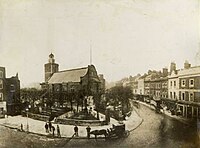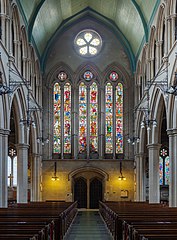St Mary Abbots
| St Mary Abbots | |
|---|---|
 St Mary Abbots Church in 2007 | |
 | |
| OS grid reference | TQ 25605 79707 |
| Location | Kensington Church Street, Kensington, London W8 4LA |
| Country | England |
| Denomination | Church of England |
| Churchmanship | High Church |
| Website | stmaryabbotschurch.org |
| History | |
| Status | Parish church |
| Consecrated | 1262 |
| Architecture | |
| Functional status | Active |
| Heritage designation | Grade II* |
| Architect(s) | Sir George Gilbert Scott |
| Style | Neo-gothic |
| Completed | 1872[1] |
| Specifications | |
| Capacity | 700[2] |
| Length | 179 feet (55m)[2] |
| Width | 109 feet (34m)[2] |
| Number of spires | One |
| Spire height | 278 feet (85m)[2] |
| Administration | |
| Province | Canterbury |
| Diocese | London |
| Episcopal area | Kensington |
| Archdeaconry | Middlesex |
| Deanery | Kensington |
| Parish | Kensington |
| Clergy | |
| Bishop(s) | The Right Revd Dr Emma Ineson |
| Vicar(s) | The Revd Mthr Emma Dinwiddy Smith |
| Assistant priest(s) | The Revd Fr Evan McWilliams and The Revd Fr Tim Carroll |
| Curate(s) | vacant |
St Mary Abbots is a church located on Kensington High Street and the corner of Kensington Church Street in London W8.
The present church structure was built in 1872 to the designs of Sir George Gilbert Scott, who combined neo-Gothic and early-English styles. This edifice remains noted for having the tallest spire in London and is the latest in a series on the site since the beginning of the 12th century.
The church, and its railings, are listed at Grade II* on the National Heritage List for England.[3]
History
[edit]Foundation
[edit]Sir Aubrey de Vere was a Norman knight who was rewarded with the manor of Kensington, among other estates, after the successful Norman Conquest. Around 1100, his eldest son, Godfrey (great-uncle of Aubrey, 1st Earl of Oxford),[4] was taken seriously ill and cared for by Faritius, abbot of the Benedictine Abbey of St Mary at Abingdon. After a period of remission, Godfrey de Vere died in 1106 aged about 19.[2]
The de Vere family's gratitude to the abbey for their son's care was recognised by its bequest of land 270 acres (1.1 km2). In 1262 the abbey founded a church and parish in Kensington, dedicated to St Mary. The epithet of Abbots is deemed to derive from its link with the ancient Abingdon Abbey rather than that subsequently with the diocese of the Bishop of London. However, this led to a dispute with the bishop and legal action followed in the diocesan consistory court. This resulted in the patronage of the church passing to the bishop in perpetuity but rights over the surrounding land remaining with the abbey.[2] The succession of vicars is recorded in a direct line back to this foundation in 1262.
Rebuilds
[edit]
In 1370 the Norman church was rebuilt.[2]
When William III relocated the Royal Court to Kensington Palace in 1689 the area became fashionable rendering the medieval church too small, thus it was demolished at the end of the 17th century and replaced by a Late Renaissance-style building. This in turn proved too small as London urbanised in the 19th century.
Around 1860 the vicar, [John Sinclair], launched a campaign for the building of a striking new church. The architect George Gilbert Scott was engaged and recommended the demolition of the existing church to take advantage of the site at the road junction. St Mary Abbot's design is almost certainly influenced by Scott's earlier work on Dunblane Cathedral - its west front's tall window and carved tympanum are similar to those in the Cathedral. The 278 ft (85 m) high spire is clearly influenced by that of St Mary Redcliffe, Bristol.[2] The present church retains many fittings from the earlier churches, especially funeral monuments from the mid-17th century onwards.
In June 2015, the church launched a major fundraising appeal, looking to raise around £7.2m,[5] to be spent on restoring the church and improving it as a community hub.
Bells
[edit]The tower holds a ring of ten bells hung for change ringing. Five of these bells – the fourth, fifth, sixth, eighth and ninth of the current ring – date from 1772 and were cast by Thomas Janaway. The other five – the treble, second, third, seventh and tenor – were cast in 1879 by John Warner & Sons.[6] The five bells were funded through a donation by Phyllis Cunliffe (1890–1974), mother to coin designer Christopher Ironside.
Primary school
[edit]The church has an associated primary school in its churchyard, founded in 1707 as a charity school.[7] The school buildings were designed by Nicholas Hawksmoor in 1711, but demolished in the 1870s to make way for a town hall. The present buildings date from 1875 and are notable for the painted stone statues by Thomas Eustace of a boy and girl, dating from about 1715,[8] now on the north face of the school; its playgrounds intersperse with the churchyard, and the school maintains close links with the Church of England.[9][10]
Notable people
[edit]Notable clergy
[edit]- Canon Donald Allchin, theologian, served his curacy here from 1956 to 1960
Notable parishioners
[edit]- Joseph Addison
- David Cameron
- George Canning
- Tennessee Claflin (married Sir Francis Cook, 1st Baronet at the church in 1885)
- Alec Clifton-Taylor
- Edmund Fanning
- Michael Gove
- Adrian Hardy Haworth
- P. D. James
- John Lockwood Kipling and Alice Kipling (parents of Rudyard Kipling, married at the church in 1865)
- Thomas Babington Macaulay
- Sir Isaac Newton (commemorated by a window in the north transept)
- Beatrix Potter (married William Heelis at the church in October 1913)[11]
- William Thackeray
- William Wilberforce
- Diana, Princess of Wales (in 1997 the church became a focus for mourners)
Gallery
[edit]-
West stained-glass window
-
Altar and nave
-
Nave wide-angle view
-
Church entrance and cloister
References
[edit]- ^ Royal Borough of Kensington and Chelsea – Churches rbkc.gov.uk, Accessed 29 July 2019
- ^ a b c d e f g h Lloyd, Dr Russell (January 2004). "The Early Churches of Kensington". www.stmaryabbotschurch.org. St Mary Abbots parish. Retrieved 7 November 2009.
- ^ Historic England. "Parish church of St Mary Abbot and railings to churchyard (1239529)". National Heritage List for England. Retrieved 7 January 2016.
- ^ British History Online: Kensington british-history.ac.uk, Accessed 29 July 2019
- ^ "St Mary Abbots Appeal". stmaryabbotsappeal.com. Archived from the original on 5 June 2015.
- ^ "Kensington—S Mary Abbots". Dove's Guide for Church Bell Ringers. 28 August 2006.
- ^ British History Online: The village centres around St. Mary Abbots church and Notting Hill Gate british-history.ac.uk, Accessed 29 July 2019
- ^ Grouped Pieces and Miscellaneous Items rbkc.gov.uk, Accessed 29 July 2019
- ^ "Children - St Mary Abbots Parish Church, Kensington". smanews.weebly.com. Archived from the original on 10 May 2011.
- ^ "St Mary Abbots Primary School". webfronter.com. Archived from the original on 20 August 2012.
- ^ Dennison, Matthew (2016). Over the hills and far away: the life of Beatrix Potter. London: Head of Zeus. p. 177. ISBN 978-1-78497-563-0.
- Allchin, A. M. (1960). St. Mary Abbots, Kensington: a brief history and guide. Favil Press.
External links
[edit]- 1262 establishments in England
- 19th-century Church of England church buildings
- Benedictine monasteries in England
- Church of England church buildings in the Royal Borough of Kensington and Chelsea
- Churches completed in 1872
- Diocese of London
- George Gilbert Scott buildings
- Grade II* listed buildings in the Royal Borough of Kensington and Chelsea
- Grade II* listed churches in London
- History of the Royal Borough of Kensington and Chelsea
- Kensington
- Rebuilt churches in the United Kingdom
- Religious organizations established in the 1100s




